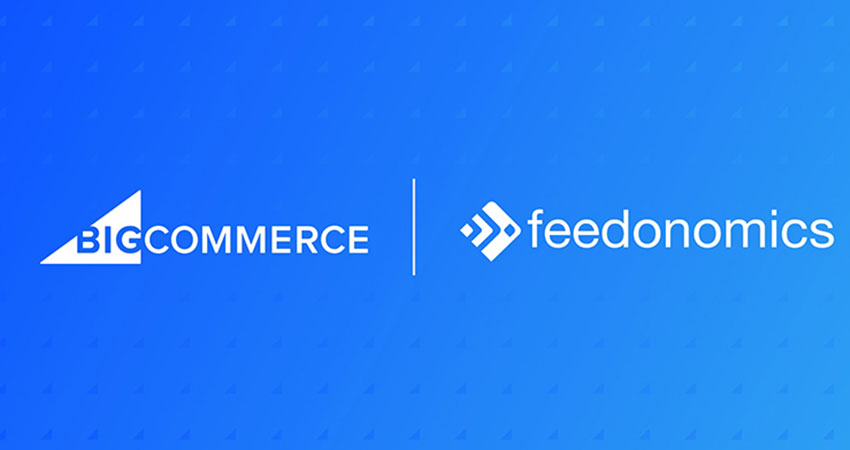BigCommerce added a significant piece to its arsenal by acquiring the assets of feed management tool provider Feedonomics for $145 million as it does battle with Shopify to be an ecommerce platform of choice for everything from SMB sellers through mid-market and enterprise companies.
BigCommerce will pay approximately $80 million in cash at closing and up to $32.5 million each one year and two years out, or upon achievement of certain milestones.
Even though BigCommerce is adding a built-in feed management component to its platform with the acquisition, the company continues to pursue a best-of-breed approach through partner integrations, while Shopify tends more toward proprietary tools, said CEO Brent Bellm.
“We knew having worked with (Feedonomics) that in terms of feed management, optimization and integration, at scale they are the best,” said Bellm. “Maybe not for every single channel, but when certainly when you look across the entirety of channels. Particularly if you want to anchor on Google and all the other channels that use its schema.”
Bellm said merchants can optimize their product listing data for Google’s schema through Feedonomics, easily adding channels. Then as needed, they can create connectors for major marketplaces like Amazon, eBay and Mercado Libre. “We see very clear use cases of customers that start in Google and other paid channels, optimizing in Feedonomics, then creating unique connectors to places like Amazon within the Feedonomics data infrastructure.”
While Feedonomics doesn’t provide ChannelAdvisor’s breath, with connections to 100+ marketplaces, Bellm said its approach views a merchant’s branded store as the hub, with added channels as the spokes, “where their model is marketplace-centric.”
“If you talk to leading ad agencies, if the data feed isn’t optimized across ad channels, their customers aren’t performing well,” he said. “They anchor on getting data feeds optimized, so their customers can spend more and get a better return. They’re using Feedonomics at scale, it’s an essential part of what they do.”
Bellm said Feedonomics’ platform is designed for mid-market or enterprise businesses, but BigCommerce will eventually offer a self-serve option geared toward SMBs. “These self-serve capabilities will be a big advantage because having it for feed optimization isn’t something an SMB merchant can get natively with other platforms,” he said.
Industry observers were generally positive about BigCommerce’s acquisition, saying it made it more competitive with Shopify, especially Shopify Plus which merchants opt for as they grow and need a richer, less self-serve ecommerce toolkit. But all said Shopify continues to be in a runaway lead, with more than a million businesses on its platform across 175 countries.
“It’s always interesting when a platform buys a vendor, sort of a yin and yang,” said Jason Goldberg of Publicis. “If I’m a BigCommerce customer, it’s appealing to have more functionality built into the core platform, it’s one less thing to buy separately. But at the same time, I may not want their specific flavor of (a feed management) solution. It could be a conundrum – do I use the platform version or a better version I may pay more for?”
Goldberg said he saw BigCommerce as more stable in terms of seller churn than Shopify, which may maintain a high user base by continually adding new accounts even as unsuccessful startups cycle through it.
Bellm said while BigCommerce doesn’t disclose churn, it does track net revenue retention of accounts at $2,000 and above of annual value, which for 2020 was at 113%, up from 106% in the prior year. “From that you can infer that churn with our customer group is quite low,” he said.
John Harmon, a senior analyst with Coresight Research, said BigCommerce’s strength is in being an open SaaS platform that serves all sizes of ecommerce companies.
“It makes sense for them to combine a marketplace and an online marketing platform,” Harmon said. “BigCommerce claims that certain channels like search, ad networks, social media and marketplaces represent ecommerce merchants’ largest non-direct sources of sales, and one of the largest spending line items. So, there is a revenue growth and cost-savings angle here.”
Gaurav Joshi, director of the retail and supply chain practices of a global management consultancy AArete, said Shopify is far and away the leader, with 3x the apps connections and 1 million-plus customers, adding BigCommerce has “been in catch-up mode” for some time. But he said the addition of Feedonomics “unlocks several doors.”
“It gives BigCommerce access to curated feeds from more than 100 global marketplaces, but they still have some way to go before they displace Shopify as the world’s most powerful platform,” Joshi said. “With features such as multi-currency support and better GDPR compliance that enables it to serve the EU marketplace better, one might argue that they are well positioned to grow globally.”

